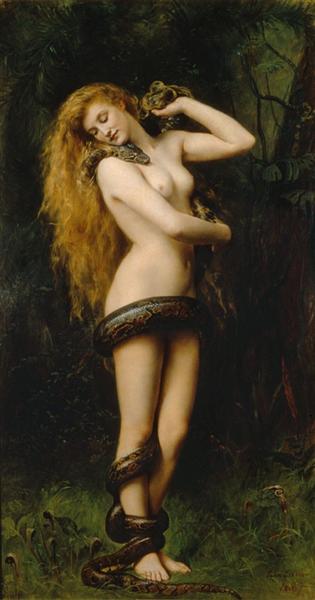
Lilith, according to Hebrew Jewish texts, was the first woman created for Adam.
After his failure, she was allowed to stay out on her own, as a witch, mother of all demons. She was allowed to kill infants up until their naming day (7 days for girls and 8 days for boys), unless they had a charm over their sleeping place with the names of the angels on them. Then, she promised, she would not kill them.
Cain was the firstborn son of Adam and Eve. He was banished, with a mark, from the land of his parents because he killed his brother in a jealous rage. In some of the legends of Jewish midrash, Cain is actually the product of an adulterous affair between Eve and the fallen angel Samael. Tellingly, Eve has a dream prior to the fratricide in which she sees, “the blood of Abel flow into the mouth of Cain, who drank it with avidity.” After the murder of Abel, Cain wandered until he found Lilith by the Red Sea. She took him in and showed him the power of blood.
From Cain and Lilith came a host of demons and vampires in the vague myths. Cain is mentioned in the Bible as having a number of legitimate children, with an unnamed woman/ wife. Some of his children are even highly regarded, as they are listed with their inventions, such as the harp and metal working. But, past Gen. 4:26 there is no more mention of Cain’s children or his line. Cain himself is referred to only twice more, in the New Testament, as “the prototype of the wicked man.”
From what there is presented in the Bible, there is little to go on with the myth of Cain and Lilith. Lilith herself appears only in Jewish apocrypha texts– she is in neither the Torah or the Bible.
Surprisingly, Cain and Lilith’s children resurfaced 1000 years later in the epic poem Beowulf, where the monster Grendel is described as one of the outlawed “clan of Cain” and with much more mention than he ever receives in the Bible. Beowulf was first written down and preserved by monks– who were the only literate people in their time. The tale originated somewhere in the 600’s in England, and was thought to have been written down at a later time.
…Till the monster stirred, that demon, that fiend,
Grendel, who haunted the moors, the wild
Marshes, and made his home in a hell
Not hell but earth. He was spawned in that slime,
Conceived by a pair of those monsters born
Of Cain, murderous creatures banished
By God, punished forever for the crime
Of Abel’s death. The Almighty drove
Those demons out, and their exile was bitter,
Shut away from men; they split
Into a thousand forms of evil– spirits
And fiends, goblins, monsters, giants,
A brood forever opposing the Lord’s
Will, and again and again defeated.
(Ll. 101-114)…Cain had killed his only
Brother, slain his father’s son
With an angry sword, God drove him off,
Outlawed him to the dry and barren desert,
And branded him with a murder’s mark. And he bore
A race of fiends accursed like their father…
(Ll. 1261-1266)
White Wolf, which produced the popular role-playing game Vampire: the Masquerade, first imagined ‘Caine’ as the original vampire in 1991. In 1993, Sam Chupp and Andrew Greenberg produced the Book of Nod, an apocryphal Bible text, as a prop for the game. In this version of the story, Cain kills his brother out of love, not jealousy. To show his devotion to God, he sacrifices that which is dearest to him: his own brother. His curse is to wander the earth forever as a vampire.
In 2003, White Wolf even sued Sony Pictures over the film Underworld, which also appeared to borrow some of their ideas about vampires and werewolves.
